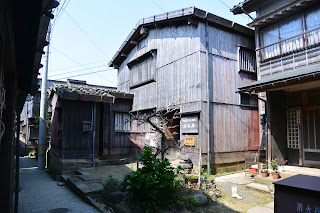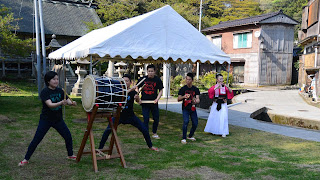Sunday 30th April 2017
Sado Island (92 kms)
Four regularities before lunch today.
The first three were fine but completely botched the fourth. A lot of navigation in this one and easy to take a wrong turn especially when the distances between tulips are particularly short. We made the out control at lunch with 3 minutes to spare as we went back to the start of Regularity Four- it was very easy when not under pressure.
Lunch was at a large school gymnasium.
Next was a short drive to the old port of Shukenegi. This port was a major trading port in the seventeenth century due to its position on the Sea of Japan.
The Kingan gold mine brought prosperity to the region and an important port for merchant shipping. The harbour is no longer accessible to larger boats as earthquake activity has raised rocks above sea level closing the harbour to all but very small boats.
Shukenegi has crowded rows of about 100 houses, built with walls from ship planks and the bridges across the canals are made from ballast stone slabs. The village is now a National Preservation area for traditional buildings and architecture.
Shukenegi is also home to the Kodo Drummers and they are only "home" from 29th April to 6th May so we were very fortunate to catch a performance of Taiko drumming. This troupe first performed at the 1981 Berlin Festival and received international acclaim for their creativity in exploring the limitless of these traditional Japanese drums. "Kodo" means children of the drum and they say they try to play with the "heart of a child". The apprenticeship is two years and only 10 in 100 get through. This was a sensational performance and the strength and stamina of this troupe is amazing. No photographs were allowed but we could take photos outside of some members of the drumming school.
After the performance we walked down to the harbour and had rides in the traditional round wooden tub boats.
The nearby Kinzan Gold Mine operated until the 1980's and was the most productive in Japan. As well as silver and copper it yielded about 400kg of gold annually. Despite wealth for the Shogunite, working conditions were miserable and workers (sent from all over Japan to work in the mines) did not survive very long.
Around this area we saw several people wearing white hoods with large red and black beaks. We later discovered that these hoods represented the Japanese crested ibis, the Nipponia Nippon. These birds are now being bred and nurtured to restore the population which almost came to extinction in the early 2000's. Even our hotel had a notice in our rooms that they were providing us with "Ecology Towels", unbleached and without fluorescent substances" in order to protect these birds.
After an interesting day we drove back to the same hotel as last night.
Sado Island (92 kms)
Four regularities before lunch today.
The first three were fine but completely botched the fourth. A lot of navigation in this one and easy to take a wrong turn especially when the distances between tulips are particularly short. We made the out control at lunch with 3 minutes to spare as we went back to the start of Regularity Four- it was very easy when not under pressure.
Lunch was at a large school gymnasium.
Next was a short drive to the old port of Shukenegi. This port was a major trading port in the seventeenth century due to its position on the Sea of Japan.
The Kingan gold mine brought prosperity to the region and an important port for merchant shipping. The harbour is no longer accessible to larger boats as earthquake activity has raised rocks above sea level closing the harbour to all but very small boats.
Shukenegi has crowded rows of about 100 houses, built with walls from ship planks and the bridges across the canals are made from ballast stone slabs. The village is now a National Preservation area for traditional buildings and architecture.
Shukenegi is also home to the Kodo Drummers and they are only "home" from 29th April to 6th May so we were very fortunate to catch a performance of Taiko drumming. This troupe first performed at the 1981 Berlin Festival and received international acclaim for their creativity in exploring the limitless of these traditional Japanese drums. "Kodo" means children of the drum and they say they try to play with the "heart of a child". The apprenticeship is two years and only 10 in 100 get through. This was a sensational performance and the strength and stamina of this troupe is amazing. No photographs were allowed but we could take photos outside of some members of the drumming school.
After the performance we walked down to the harbour and had rides in the traditional round wooden tub boats.
The nearby Kinzan Gold Mine operated until the 1980's and was the most productive in Japan. As well as silver and copper it yielded about 400kg of gold annually. Despite wealth for the Shogunite, working conditions were miserable and workers (sent from all over Japan to work in the mines) did not survive very long.
Around this area we saw several people wearing white hoods with large red and black beaks. We later discovered that these hoods represented the Japanese crested ibis, the Nipponia Nippon. These birds are now being bred and nurtured to restore the population which almost came to extinction in the early 2000's. Even our hotel had a notice in our rooms that they were providing us with "Ecology Towels", unbleached and without fluorescent substances" in order to protect these birds.
After an interesting day we drove back to the same hotel as last night.










No comments:
Post a Comment